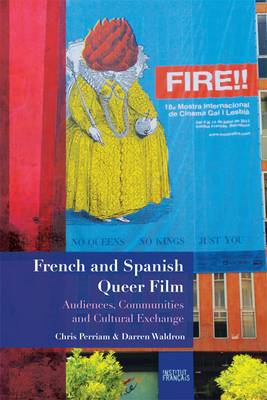
- Afhalen na 1 uur in een winkel met voorraad
- Gratis thuislevering in België vanaf € 30
- Ruim aanbod met 7 miljoen producten
- Afhalen na 1 uur in een winkel met voorraad
- Gratis thuislevering in België vanaf € 30
- Ruim aanbod met 7 miljoen producten
French and Spanish Queer Film
Audiences, Communities and Cultural Exchange
Chris Perriam, Darren WaldronOmschrijving
Headline: Examines how LGBT filmmaking in France and Spain moves across borders and finds new audiences
Blurb: The book advances the current state of film audience research and of our knowledge of sexuality in transnational contexts by analysing how French LGBTQ films are seen in Spain and Spanish ones in France. It studies films (in various media and platforms) and their reception across four languages (Spanish, French, Catalan, English) and considers and engages with participants from across a range of digital and physical audience locations, with a particular focus on festivals. It examines films that chronicle the local (in portraying national and sub-national identities) and draws on the regional-global (translating and transferring foreign models of non-heterosexual experience). No comparative and crosscutting study with audience research at its heart has yet been undertaken.
Key Features:
Offers a full, clear, and comparative cultural history of LGBTQ film since the 1990s in France and Spain and of its activist and theory-inspired connectionsHas audience reception at the core, working with an extensive corpus of responses
Makes broad use of social networking sites and the popular LGBTQ press to gauge response
Covers LGBTQ festivals including those in Barcelona, Bilbao, London, Lyon, Madrid, Manchester, Paris and Toulouse
Is interested in short, independent, ephemeral and documentary film production as well as commercially-pitched feature films
Looks at the cross-border impact of the auteur and big-name directors (e.g. Pedro Almodóvar, Cesc Gay, Sébastien Lifshitz, François Ozon)
Sets its findings against mainstream LGBTQ critical reception, written in Catalan, English, French, and Spanish
Keywords: French cinema; Spanish cinema; audiences; LGBTQ cultures; lesbian and gay film festivals
Subject: Film Studies
Headline: Examines how LGBT filmmaking in France and Spain moves across borders and finds new audiences
Blurb: The book advances the current state of film audience research and of our knowledge of sexuality in transnational contexts by analysing how French LGBTQ films are seen in Spain and Spanish ones in France. It studies films (in various media and platforms) and their reception across four languages (Spanish, French, Catalan, English) and considers and engages with participants from across a range of digital and physical audience locations, with a particular focus on festivals. It examines films that chronicle the local (in portraying national and sub-national identities) and draws on the regional-global (translating and transferring foreign models of non-heterosexual experience). No comparative and crosscutting study with audience research at its heart has yet been undertaken.
Key Features:
Offers a full, clear, and comparative cultural history of LGBTQ film since the 1990s in France and Spain and of its activist and theory-inspired connectionsHas audience reception at the core, working with an extensive corpus of responses
Makes broad use of social networking sites and the popular LGBTQ press to gauge response
Covers LGBTQ festivals including those in Barcelona, Bilbao, London, Lyon, Madrid, Manchester, Paris and Toulouse
Is interested in short, independent, ephemeral and documentary film production as well as commercially-pitched feature films
Looks at the cross-border impact of the auteur and big-name directors (e.g. Pedro Almodóvar, Cesc Gay, Sébastien Lifshitz, François Ozon)
Sets its findings against mainstream LGBTQ critical reception, written in Catalan, English, French, and Spanish
Keywords: French cinema; Spanish cinema; audiences; LGBTQ cultures; lesbian and gay film festivals
Subject: Film Studies
Specificaties
Betrokkenen
- Auteur(s):
- Uitgeverij:
Inhoud
- Aantal bladzijden:
- 216
- Taal:
- Engels
Eigenschappen
- Productcode (EAN):
- 9780748699193
- Verschijningsdatum:
- 17/06/2016
- Uitvoering:
- Hardcover
- Formaat:
- Genaaid
- Afmetingen:
- 163 mm x 236 mm
- Gewicht:
- 453 g

Alleen bij Standaard Boekhandel
Beoordelingen
We publiceren alleen reviews die voldoen aan de voorwaarden voor reviews. Bekijk onze voorwaarden voor reviews.











